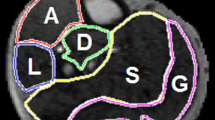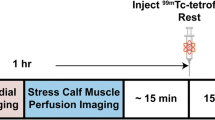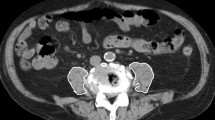Abstract
Carnitine derivatives, such as propionyl-l-carnitine (PLC), have been shown to improve walking distance in patients with obstructive peripheral artery disease (PAOD). The aim of this study was to ascertain whether technetium-99m sestamibi leg scintigraphy may be a useful tool in the evaluation of changes in skeletal muscle metabolism induced by chronic therapy with PLC. Twenty patients with clinical and instrumental evidence of PAOD were randomly assigned to a 3-month period of therapy with either PLC or placebo. Rest99mTc-sestamibi leg scintigraphy and echo-Doppler sonography were performed on all subjects immediately before and upon completion of the treatment period. At the end of the protocol the following results were observed in patients who underwent PLC administration: (a) a significant increase in both thigh and calf99mTc-sestamibi uptake, in comparison with baseline values (P<0.001); (b) the absence of statistically significant modifications of Doppler blood flow indices of the lower limbs. In conclusion, after chronic administration of PLC, a significant increment in skeletal muscle uptake of99mTc-sestamibi was demonstrated without any apparent change in regional blood flow. This fact, if proven in further studies, may suggest a role for this tracer as a non-invasive probe of tissue bioenergetics.
Similar content being viewed by others
References
Kiat H, Maddahi J, Roy LT, Van Train K, Friedman J, Resser K, Berman DS. Comparison of technetium 99m isonitrile and thallium 201 for evaluation of coronary artery disease by planar and tomographic methods.Am Heart J 1989; 117: 1–11.
Baillet GY, Mena IG, Kuperus JH, Robertson JM, French WJ. Simultaneous technetium-99m MIBI angiography and myocardial perfusion imaging.J Nucl Med 1989; 30: 38–44.
Sayman HB, Urgancioglu I. Muscle perfusion with technetium-MIBI in lower extremity peripheral arterial diseases.J Nucl Med 1991; 32: 1700–1703.
Miles KA, Barber RW, Wraight EP, Cooper M, Appleton DS. Leg muscle scintigraphy with99mTc-MIBI in the assessment of peripheral vascular (arterial) disease.Nucl Med Commun 1992; 13: 563–603.
Bajnok L, Kozlovsky B, Varga J, Antalffy J, Olvasztò S, Fülöp T Jr. Technetium-99m sestamibi scintigraphy for the assessment of lower extremity ischaemia in peripheral arterial disease.Eur J Nucl Med 1994; 21: 1326–1332.
Beanlands RSB, Dawood F, Wen WH, McLaughlin PR, Butany J, D'Amati G, Liu PP. Are the kinetics of technetium-99m methoxyisobutyl isonitrile affected by cell metabolism and viability?Circulation. 1990; 82: 1802–1814.
Piwnica-Worms D, Kronauge JF, Chin ML. Uptake and retention of hexakis (2-methoxyisobutylisonitrile) technetium (I) in cultured chick myocardial cells: mitochondrial and plasma membrane potential-dependence.Circulation 1990; 82: 1826–1838.
Chin ML, Kronauge JF, Piwnica-Worms D. Effect of mitochondrial and plasma membrane potentials on accumulation of hexakis (2-methoxyisobutylisonitrile) technetium (I) in cultured mouse fibroblasts.J Nucl Med 1990; 31: 1646–1653.
Delmon-Moingeon LL Piwnica-Worms D. Van den Abbeele AD, Holman BL, Davison A, Jones AG. Uptake of the cation hexakis (2-methoxyisobutylisonitrile)-technetium-99m by human carcinoma cell lines in vitro.Cancer Res 1990; 50: 2198–2202.
Carvalho PA, Chin ML, Kronauge JF, Kawamura M, Jones AG, Holman BL, Piwnica-Worms D. Subcellular distribution and analysis of technetium-99m-MIBI in isolated perfused rat hearts.J Nucl Med 1992; 33: 1516–1521.
Hülsmann WC. Biochemical profile of propionyl-l-carnitine.Cardiovasc Drugs Ther 1991; 5: 7–9.
Brevetti G, Chiariello M, Ferulano G, Policicchio A, Nevola E, Rossini A, Attisano T, Ambrosio G, Siliprandi N, Angelini C. Increases in walking distance in patients with peripheral vascular disease treated with L-carnitine: a double-blind, cross-over study.Circulation 1988; 77:767–773.
Brevetti G, Perna S, Sabbà C, Rossini A, Scotto di Uccio V, Berardi E, Godi L. Superiority ofl-propionyl-carnitine vsl-carnitine in improving walking capacity in patients with peripheral vascular disease. An acute, intravenous, double-blind, cross-over study.Eur Heart J 1992; 13: 251–255.
Coto V, D'Alessandro L, Grattarola G, Imparato L, Lingetti M, Mancini M, Nolfe G, Rengo F. Evaluation of the therapeutic efficacy and tolerability of levocarnitine propionyl in the treatment of chronic obstructive arteriopathies of the lower extremities: a multicentre controlled study vs placebo.Drugs Exp Clin Res 1992: 18: 29–36.
Di Lisa F, Menabo R, Siliprandi N.l-Propionyl-carnitine protection of mitochondria in ischemic rat hearts.Mol Cell Biochem 1989; 88: 169–173.
Ferrari R, Cecconi C, Cargnoni A, Pasini E, Boffa GM, Curello S, Visioli O. The effect of propionyl-l-carnitine. on the ischemic and reperfused intact myocardium and on their derived mitochondria.Cardiovasc Drugs Ther 1991; 5: 57–65.
Reznick AZ, Kagan VE, Ramsey R, Tsuchiya M, Khwaja S, Serbinova EA, Packer L. Antiradical effect in L-propionyl carnitine protection of the heart against ischemia-reperfusion injury: the possible role of iron chelation.Arch Biochem Biophys 1992; 296: 394–401.
Sabha C, Berardi E, Antonica G, Ferraioli G, Buonamico P, Godi L, Brevetti G. Comparison between the effect ofl-propi-onylcarnitine,l-acetylcarnitine and nitroglycerin in chronic peripheral arterial disease: a haemodynamic double blind echo-Doppler study.Eur Heart J 1994; 15: 1348–1352.
Carter SA: Role of pressure measurements in vascular diseases. In: Bernstein EF eds.Non-invasive diagnostic techniques in vascular disease. St. Louis: Mosby: 1985: 513–544.
Segall GM, Lennon SE, Stevick CD. Exercise whole-body thallium scintigraphy in the diagnosis and evaluation of occlusive arterial disease in the legs.J Nucl Med 1990; 31: 1443–1449.
Nicholson ML, Byrne RL, Steele GA, Callum KG. Predictive value of bruits and Doppler pressure measurements in detecting lower limb arterial stenosis.Eur J Vasc Surg 1993; 7: 59–62.
Allen PI, Goldman M. Skin blood flow: a comparison of transcutaneous oximetry and laser Doppler flowmetry.Eur J Vasc Surg 1987; 1: 315–318.
Holm J, Frid I, Akerstrom G, Haljamae H. Ankle-brachial index (ABI) and leg blood flow following epidural anaesthesia.Int Angiol 1988; 7: 26–31.
Hamanaka D, Odori T, Maeda H, Ishii Y, Hayakawa K, Torizuka K. A quantitative assessment of scintigraphy of the legs using201Tl.Eur J Nucl Med 1984; 9: 12–16.
Cittanti C, Giganti M, Colamussi P, Galeotti R, Saletti A, Mannella P, Piffanelli A. The role of muscle scintigraphy with201Tl in the morphofunctional assessment of obliterative arterial pathology of the lower limbs.Radial Med (Torino) 1995; 89:495–500.
Crane P, Laliberté R, Heminway S, Thoolen M, Orlandi C. Effect of mitochondria) viability and metabolism on technetium99m-sestamibi myocardial retention.Eur J Nucl Med 1993; 20: 20–25.
Uccelli L, Giganti M, Duatti A, Bolzati C, Pasqualini R, Cittanti C, Colamussi P, Piffanelli A. Subcellular distribution of technetium-99m-N-NOEt in rat myocardium.J Nucl Med 1995; 36: 2075–2079.
Corbucci GG, Montanari G, Mancinelli G, D'Iddio S. Metabolic effects induced by t-carnitine and prop ionyI-l-carnitine in human hypoxic muscle tissue during exercise.Int J Clin Pharmacol Res 1990; 10: 197–202.
Author information
Authors and Affiliations
Rights and permissions
About this article
Cite this article
Cittanti, C., Colamussi, P., Giganti, M. et al. Technetium-99m sestamibi leg scintigraphy for non-invasive assessment of propionyl-l-carnitine induced changes in skeletal muscle metabolism. Eur J Nucl Med 24, 762–766 (1997). https://doi.org/10.1007/BF00879664
Received:
Revised:
Issue Date:
DOI: https://doi.org/10.1007/BF00879664




